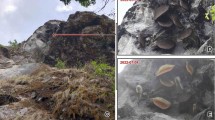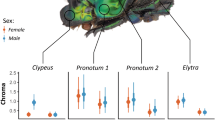Abstract
We document the variation in number of queens occurring naturally in founding, immature and mature nests of the ant Formica podzolica, and compare development of colonies and survivorship of queens in experimental nests started with 1–16 foundresses. Number of queens per nest was associated with stage of colony development. Most nests were monogynous, but 20% of immature nests (n = 66) and 25% of mature nests (n = 92) were oligogynous or polygynous. Colonies were usually established by single queens (i.e., haplometrosis), but colony establishment by multiple queens (i.e., pleometrotis) was also common, occurring in 27% of founding nests (n = 492). Foundress groups in the field were small ( = 1.47 ± 0.04 queens/nest), and large groups experienced high mortality and low productivity in artificial nests. Therefore, the many queens (up to 140) in some immature and mature colonies were probably secondarily pleometrotic. Experimental nests started with 1–4 queens were more successful than those initiated by 8 or 16 queens. Small groups (2–4 queens) produced more pupae before the first nests reared workers than single foundresses or larger groups (8 or 16 queens). Although single foundresses were less productive than queens in small groups, they experienced greater survivorship and less weight loss than queens in pleometrotic associations. Besides low productivity, queen mortality and weight loss were greatest in large groups.
Similar content being viewed by others
References
Bartz SH, Hölldobler B (1982) Colony founding in Myrmecocystus mimicus Wheeler (Hymenoptera: Formicidae) and the evolution of foundress associations. Behav Ecol Sociobiol 10:137–147.
Bennett B (1989a) Nestmate recognition systems in a monogynous-polygynous species pair of ants (Hymenoptera: Formicidae).I. Worker and queen derived cues. Sociobiology 16:121–139.
Bennett B (1989b) Nestmate recognition systems in a monogynous-polygynous species pair of ants (Hymenoptera: Formicidae).II. Environmental factors. Sociobiology 16:141–147.
Buschinger A (1986) Evolution of social parasitism in ants. Trends Ecol Evol 1:155–160.
Dejean A (1987) New cases of archaic foundation of societies in Myrmicinae (Formicidae): study of prey capture by queens of Dacetini. Insectes Soc 34:211–221.
Deslippe RJ, Savolainen R (1994) Role of food supply in structuring a population of Formica ants. J Anim Ecol 63:756–764.
Deslippe RJ, Savolainen R (1995a) Mechanisms of competition in a guild of formicine ants. Oikos 72:67–73.
Deslippe RJ, Savolainen R (1995b) Sex investment in a social insect: the proximate role of food. Ecology 76:375–382.
Elmes GW (1973) Observations on the density of queens in natural colonies of Myrmica rubra L. (Hymenoptera: Formicidae). J Anim Ecol 42:761–771.
Francoeur A (1973) Révision taxonomique des espèces néarctiques du groupe fusca, genre Formica (Formicidae, Hymenoptera). Mém Soc Entomol Québec 3:1–316.
Hagen RH, Smith DR, Rissing SW (1988) Genetic relatedness among co-foundresses of two desert ants, Veromessor pergandei and Acromyrmex versicolor (Hymenoptera: Formicidae). Psyche 95:191–202.
Haskins CP (1970) Researches in the biology and social behaviour of primitive ants. In: Aronson E, Tobach DS, Lehrman DS, Rosenblatt JS (eds) Development and evolution of behaviour: Essays in memory of TC Schneirla. Freeman, San Francisco, pp 355–388.
Hölldobler B, Carlin NF (1985) Colony founding, queen dominance and oligogyny in the Australian meat ant Iridomyrmex purpureus. Behav Ecol Sociobiol 18:45–58.
Hölldobler B, Carlin NF (1989) Colony founding, queen control and worker reproduction in the ant Aphaenogaster (=Novomessor) cockerelli (Hymenoptera: Formicidae). Psyche 96:131–152.
Hölldobler B, Wilson EO (1977) The number of queens: an important trait in ant evolution. Naturwissenschaften 64:8–15.
Hölldobler B, Wilson EO (1990) The ants. Harvard University Press, Cambridge.
Janzen DH (1973) Evolution of polygynous obligate acacia-ants in western Mexico. J Anim Ecol 42:727–750.
Keller L (1991) Queen number, mode of colony foundation and queen reproductive success in ants (Hymenoptera, Formicidae). Ethol Ecol Evol 3:307–316.
Keller L (1993) Queen number and sociality in insects. Oxford University Press, New York.
Keller L, Passera L (1989) Size and fat content of gynes in relation to the mode of colony founding in ants (Hymenoptera: Formicidae). Oecologia 80:236–240.
Michener CD (1974) The social behavior of the bees. Harvard University Press, Cambridge.
Mintzer AC (1979) Colony founding and pleometrosis in Camponotus (Hymenoptera: Formicidae). Pan Pac Entomol 55:81–89.
Mintzer AC (1987) Primary polygyny in the ant Atta texana: number and weight of females and colony foundation success in the laboratory. Insectes Soc 34:108–117.
Nichols BJ, Sites RW (1991) Ant predators of founder queens of Solenopsis invicta (Hymenoptera: Formicidae) in Central Texas. Environ Entomol 20:1024–1029.
Oster GE, Wilson EO (1978) Caste and ecology in the social insects. Princeton University Press, Princeton.
Packer L (1986) Multiple-foundress associations in a temperate population of Halictus ligatus (Hymenoptera: Halictidae). Can J Zool 64:2325–2332.
Pollock GB, Rissing SW (1989) Intraspecific brood raiding, territoriality, and slavery in ants. Am Nat 133:61–70.
Pratte M (1990) Effects of changes in brood composition of the activities of three associated foundresses of the paper wasp Polistes dominulus (Christ). Behav Processes 22:187–195.
Rissing SW, Pollock GB (1986) Social interaction among pleometrotic queens of Veromessor pergandei (Hymenoptera: Formicidae) during colony foundation. Anim Behav 34:226–233.
Rissing SW, Pollock GB (1987) Queen aggression, pleometrotic advantage and brood raiding in the ant Veromessor pergandei (Hymenoptera: Formicidae). Anim Behav 35:975–981.
Rissing SW, Pollock GB (1988) Pleometrosis and polygyny in ants. In: Jeanne RL (ed) Interindividual behavioral variability in social insects. Westview, Boulder, pp 179–223.
Rissing SW, Pollock GB (1991) An experimental analysis of pleometrotic advantage in the desert seed-harvester ant Messor Pergandei (Hymenoptera: Formicidae). Insectes Soc 38:205–211.
Rissing SW, Pollock GB, Higgins MR, Hagan RH, Smith DR (1989) Foraging specialization without relatedness or dominance among co-founding ant queens. Nature 338:420–422.
Rosengren R, Sundström L, Fortelius W (1993) Monogyny and polygyny in Formica ants: the result of alternative dispersal tactics. In: Keller L (ed) Queen number and sociality in insects. Oxford University Press, New York, pp 308–333.
Scherba G (1958) Reproduction, nest orientation and population structure of an aggregation of mound nests of Formica ulkei Emery (“Formicidae”). Insectes Soc 5:201–213.
Schneirla TC (1971) Army ants. Freeman, San Francisco.
Strassmann, JE (1989) Altruism and relatedness at colony foundation in social insects. Trends Ecol Evol 4:371–374.
Tschinkel WR (1992a) Brood raiding and the population dynamics of founding and incipient colonies of the fire ant, Solenopsis invicta. Ecol Entomol 17:179–188.
Tschinkel WR (1992b) Brood raiding in the fire ant, Solenopsis invicta (Hymenoptera: Formicidae): laboratory and field observations. Ann Entomol Soc Am 85:638–646.
Tschinkel WR (1993) Resource allocation, brood production and cannibalism during colony founding in the fire ant, Solenopsis invicta. Behav Ecol Sociobiol 33:209–223.
Tschinkel WR, Howard DF (1983) Colony founding by pleometrosis in the fire ant, Solenopsis invicta. Behav Ecol Sociobiol 12:103–113.
Waloff N (1957) The effect of the number of queens of the ant Lasius flavus (Fab.) (Hym. Formicidae) on their survival and on the rate of development of the first brood. Insectes Soc 4:391–408.
Weber NA (1972) Gardening ants. American Philosophical Society, Philadelphia.
Whitcomb WH, Bhatkar A, Nickerson JC (1973) Predators of Solenopsis invicta queens prior to successful colony establishment. Environ Entomol 2:1001–1003.
Wilson EO (1971) The insect societies. Harvard University Press, Cambridge.
Zar JH (1984) Biostatistical analysis. Prentice-Hall, Englewood Cliffs.
Author information
Authors and Affiliations
Rights and permissions
About this article
Cite this article
Deslippe, R.J., Savolainen, R. Colony foundation and polygyny in the ant Formica podzolica . Behav Ecol Sociobiol 37, 1–6 (1995). https://doi.org/10.1007/BF00173892
Received:
Accepted:
Issue Date:
DOI: https://doi.org/10.1007/BF00173892




